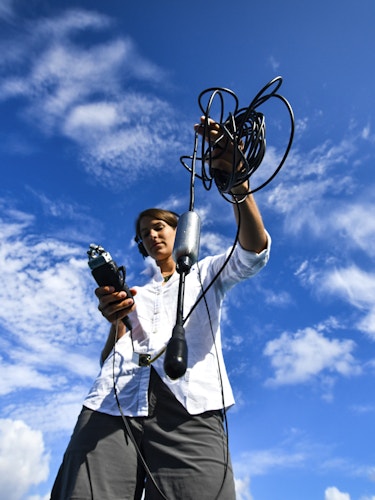
Marine pollution monitoring programme
This monitoring programme focuses on atmospheric pollution, water pollution and noise pollution in the oceans. Measurements will be carried out from aboard the Energy Observer catamaran using the on-board science stations, one of them assessing the water quality, the other air quality, whilst the measurement of (non-continuous) noise pollution will also be taken using a dedicated sensor. This data will be coupled with information collected via the on-board navigation system (wind, sunshine, marine current, depth, etc.) to provide an accurate picture of the environment surrounding the boat.
Focus area
1 Act for energy transition
More project information
Problematic
As many ships as fish in the ocean
Our oceans are filling up with ships. Today, the global commercial fleet comprises around 95,000 vessels (source Marine Traffic) weighing in at a total of 1.92-billion tonnes of dead weight (light ship). Bulk carriers, which transport iron ore, coal, grain and other cargo, represent the largest proportion of the total tonnage, namely more than 40%.
It is reckoned that in terms of weight, there are as many ships as fish in the ocean. This global commercial fleet transports a total of 10.7-billion tonnes of freight each year, which represents 80% of the total global trade in terms of volume according to the IMO.
To pull off such a feat, ships have become larger, more numerous and capable of crossing the oceans at ever increasing speeds. The intensification of maritime shipping is having a considerable impact on marine ecosystems. Today, the issue of maritime pollution is central to protagonists involved in ecological transition and the maritime sector.
Solution
Measuring air, water and noise pollution
Today, there is in-depth analysis of the atmospheric pollution in the globe’s major cities and in numerous ports. The damage to human health caused by certain pollutants, associated with industrialisation and transport (land, air or sea), has prompted more diligent monitoring of the air quality in cities. Multiple platforms make it possible to view this real-time online data. Measurements taken offshore or on the approach to ports are much more rare or, where they exist, they are taken from the vessels which are themselves polluting the air.
From 2022, the goal of measuring air pollution from Energy Observer involves continuous monitoring of numerous polluting emissions.
When it comes to water quality, direct and indirect pollution linked to maritime activities can alter its acidity levels or even lead to eutrophication.
With regards to noise pollution, there are two types.
Firstly, there is chronic pollution resulting from maritime traffic (vibrations and the noise from engines, cooling pumps, propeller cavitation, etc.), which has an impact on all underwater life with long-term repercussions on man’s health and the health of marine fauna.
Secondly, there is high-pitched noise pollution caused by seismic surveys blasting compressed air. The impact of these seismic surveys on the rest of the underwater creatures is still not widely known. However, the evidence is mounting and it is alarming.
The Energy Observer catamaran is the perfect platform for measuring atmospheric and noise pollution since it produces no direct emissions and is silent.
Impact
Raising awareness among boat operators about the preservation of marine ecosystems
The end goal is to create a trend chart grouping together all the environmental data in order to make optimum use of it and make it widely accessible. This visualisation will be an important educational tool in the bid to combat maritime pollution.
The raw data will also be available to boat operators, scientists and meteorologists to stimulate more extensive research into solutions to bring about an ecological transition of marine transport.
Today, the majority of vessels use routing software and energy performance measurements. Tomorrow, why not have a device for monitoring their environmental impact?




